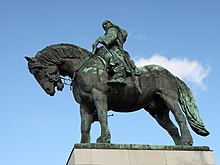National monument on Vitusberg

The National Monument on Vitus Hill (Czech Národní památník na Vítkově , also known as Žižka Monument ) is a patriotic monument in honor of the Hussite leader Jan Žižka in Prague - Žižkov .
description
The National monument on the Veitsberg ( Vítkov ) consists of a 9 meter high and 16.5 ton equestrian January Žižka and from behind of a subsequent multi-storey Ehrenhalle which is m high interior covered with marble and overall 31st The entire system of the national monument has a length of 143 m, in addition it includes numerous underground rooms in the area of the equestrian statue and hall of honor, in which u. a. the grave of the unknown soldier is housed. The Žižka equestrian statue is considered to be one of the largest bronze statues in the world.
history
The idea for the Žižka monument on Vitus Hill in the Žižkov district - also named after Žižka - came about as early as 1877. The decision to build was made in 1882. In 1907 a piece of land was made available by the city of Prague free of charge, and construction began in 1928.
In 1931 the equestrian statue of Jan Žižkas was erected, the work of the sculptor Bohuslav Kafka and one of the largest bronze equestrian monuments in Europe. A large inauguration ceremony planned for 1938 was canceled due to the Munich Agreement , so that the facility was not completed until after the Second World War under the communist regime of Czechoslovakia .
The monument was finally inaugurated in 1950. The Vítkov was also renamed in Žižka's honor in Vrch Žižkov . However, the Stalinist rulers in the post-war period abused the original idea of the national monument and set up a memorial there for selected deceased members of the Czechoslovak Communist Party . So they had the head of state Klement Gottwald, who died in 1953, embalmed and buried at the national monument in the mausoleum originally intended for Tomáš Garrigue Masaryk . Gottwald's body was cremated in 1962 ; his urn and the urns of 20 other communists were finally removed from the mausoleum in 1990 after the Velvet Revolution and buried in a collective grave in the Olšany cemeteries .
Today the building houses historical exhibitions of the National Museum .
Tomb of the Unknown Soldier
Inside the national monument there is also the tomb of the Unknown Soldier of the Czech People with a memorial to the fallen. In 2006 the urns of Alois Eliáš and his wife Jaroslava were solemnly buried in the national monument.
Individual evidence
- ↑ Some historians claim that Gottwald's body had to be removed because the embalming failed. Many experts question this. The real reason, however, seems to be that in 1962 the era of the "personality cult" in Czechoslovakia was over.
- ↑ Solemn burial of General Alois Elias 64 years after his death ( memento from September 7, 2012 in the web archive archive.today ) on Radio Prague from July 5, 2006, accessed on April 26, 2011
Web links
- National monument on Vitusberg Visitor information on the website of the National Museum (Czech)
- National monument plan (cross-section)
- Detailed description (Czech)
Coordinates: 50 ° 5 ′ 19.4 ″ N , 14 ° 26 ′ 59.9 ″ E


